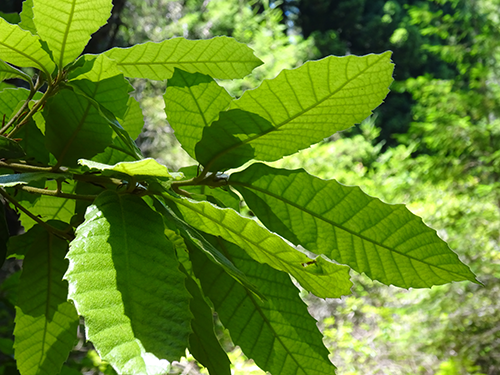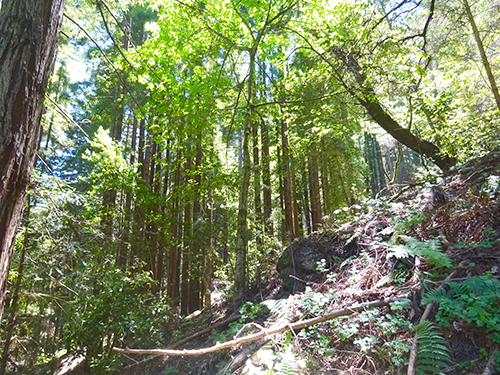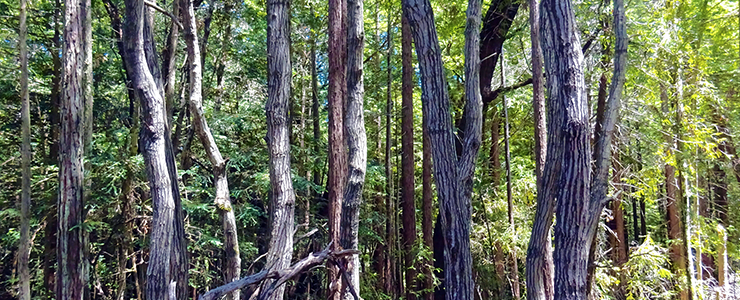East Slope
East Slope (15 acres)
 General Description: East and north of Chinquapin Road lays an area of the reserve that contains a well-developed stand of giant chinquapin (Chrysolepsis chrysophylla) and dwarf redwoods. This is the only reserve site with an east-southeast exposure, and is thus valuable for comparative studies. Two small, spring-fed drainages cross the site and descend the steep eastern slope toward the San Lorenzo River drainage.
General Description: East and north of Chinquapin Road lays an area of the reserve that contains a well-developed stand of giant chinquapin (Chrysolepsis chrysophylla) and dwarf redwoods. This is the only reserve site with an east-southeast exposure, and is thus valuable for comparative studies. Two small, spring-fed drainages cross the site and descend the steep eastern slope toward the San Lorenzo River drainage.
Geology: Schist makes up the basement complex of the grove (Stanley 1983), and is overlain by an unnamed sandy loam and Felton rocky loam (Arkley 1963).
 Plants: The unique values of this section include the population of giant chinquapin, a species that reaches its southern limit on the UCSC campus (Stone 1983). According to Buck (1983), the largest and most extensive population of giant chinquapins on campus occurs northwest of Crown Meadow. However, he stated that many of these trees are now dead or dying, possibly because of historical prescribed burning. Weiner and Norris (1983), in contrast, noted that the chinquapin population on the East Slope reserve land appeared to be quite healthy. Thirty years later, however, many of these trees have either died or are declining in vigor.
Plants: The unique values of this section include the population of giant chinquapin, a species that reaches its southern limit on the UCSC campus (Stone 1983). According to Buck (1983), the largest and most extensive population of giant chinquapins on campus occurs northwest of Crown Meadow. However, he stated that many of these trees are now dead or dying, possibly because of historical prescribed burning. Weiner and Norris (1983), in contrast, noted that the chinquapin population on the East Slope reserve land appeared to be quite healthy. Thirty years later, however, many of these trees have either died or are declining in vigor.
Also of interest is this site’s dense, pure stand of dwarf redwoods. Dashe (1982) stated that these small trees are at least sixty years old (making them at least ~90 years old as of this report), as old as other normal-sized campus redwoods. The poor surface soil of the area may affect the redwoods’ growth, for they spread their roots near the surface and are thus affected by soil texture (Dashe 1982). Thirty years later, these trees remain small (both in diameter and height) in comparison to other larger campus redwoods.
Animals: A population of California forest scorpion (Uroctonus mordax) has been observed just to the west of the East Slope parcel (A. Jones, pers. obs. 2012-2014). It is likely that this species also inhabits redwood forest and chinquapin areas of the East Slope parcel. The dwarf redwoods and chinquapin areas feature salamanders such as the yellow-eyed ensatina (Ensatina eschscholtzii xanthoptica), slender salamander (Batrachoseps sp.), and arboreal salamander (Aneides lugubris). In spring 2014, two mountain lion scrapes were also found along a contour trail that crosses the two spring-fed ravines and is infrequently used by people (A. Jones, pers. obs.).
Management: This area has not received management in recent decades.
Opportunities for teaching, research, and stewardship: The East Slope reserve is accessible to classes for field trips, as it lies in close proximity to the Chinquapin Rd entrance to Upper Campus. Classes can meet at the Chinquapin Rd gate and be in the East Slope section within 10 minutes. There are few developed trails in the parcel, however, so courses are limited to off-trail work and/or use of unauthorized bike trails. Dwarf redwood, soils, and forest spring-related research are possible in this parcel. Stewardship opportunities include trail maintenance and closures, erosion control, and trash/stick fort/fire pit clean-ups.

